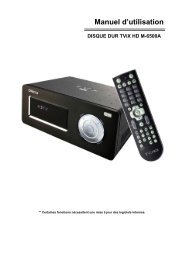MECABLITZ 50 AF-1 digital - Materiel.net
MECABLITZ 50 AF-1 digital - Materiel.net
MECABLITZ 50 AF-1 digital - Materiel.net
Create successful ePaper yourself
Turn your PDF publications into a flip-book with our unique Google optimized e-Paper software.
�<br />
10.4 Flash exposure memory<br />
Some Group E cameras (see Table 1) have flash exposure memory (FV memory).<br />
This is supported by the flash unit in i-TTL and i-TTL BL flash mode. It can be<br />
used to define and store the exposure level for the subsequent shot before the<br />
shot is actually taken. This can be useful when, for example, the flash exposure<br />
has to be adjusted to specific details that may not be necessarily be identical<br />
with the main subject.<br />
The function is activated on the camera, in some instances as an individual function.<br />
The subject detail to which the flash exposure is to be adjusted is sighted<br />
and brought into focus with the <strong>AF</strong> sensor/metering window in the camera.<br />
When the AE-L/<strong>AF</strong>-L button (the terminology may vary with the camera model)<br />
on the camera is pressed, the flash unit fires a test flash. The stored metering<br />
value, for example „EL“, is then displayed in the camera viewfinder. The camera<br />
uses the reflected light of the test flash to determine the light output required for<br />
the subsequent exposure.<br />
The actual main subject can then be brought into focus with the camera’s<br />
<strong>AF</strong> sensor/metering window. When the shutter release is pressed, the picture<br />
will be exposed with the previously defined light output of the flash unit!<br />
☞<br />
For more detailed information on adjustments and handling, refer to the<br />
camera’s operating instructions!<br />
108





